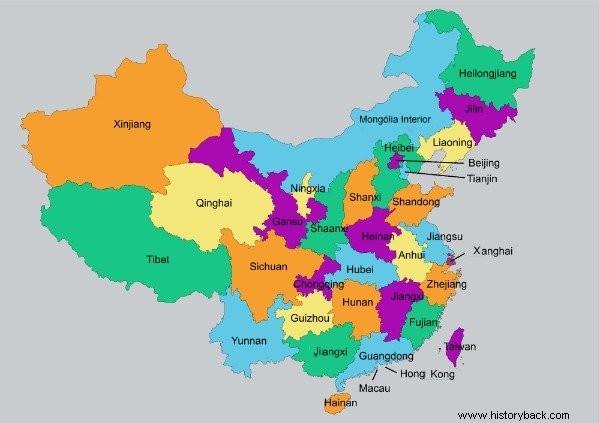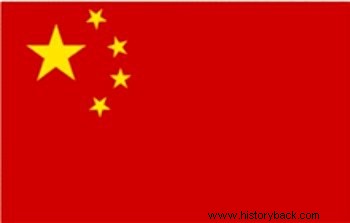China, officially the People's Republic of China since 1949, is one das civilizations more ancient from world . It is also the most populous country and the second largest economic power in the world.
Located in East Asia, China is the third largest country in the world, after Russia and Canada.
It borders 14 countries:Afghanistan, Bhutan, Kazakhstan, Korea, India, Laos, Myanmar, Mongolia, Nepal, Pakistan, Kyrgyzstan, Russia, Tajikistan and Vietnam.
The country is bordered by the Pacific Ocean and the Bohai, Huanghai, Donghai and Nanhai Seas.

General Data
- Capital:Beijing (Beijing)
- Language:Mandarin
- Religion:Taoism Prevails
- Currency:Renminbi
- Political System:Socialism
- Type of Government:Communist Republic
- Territorial extent:9,596,960 km²
- Inhabitants:1,439,323,774 (2020 data)
- Human Development Index – HDI:0.751
- Gross Domestic Product – GDP:US$ 14.72 trillion
- Climate:continental in the north, center and northeast and humid tropical in the south and southeast
According to IBGE data, 96.84% of the population over 15 years old is literate.
In a country where the population density is around 153.31 inhab/km 2 , a strong policy of control from natality . Couples are encouraged to have only 1 child.
Flag

The flag of China is red, which represents the Chinese Revolution of 1949, and contains 5 yellow stars. One of these stars, the largest, symbolizes the Communist Party of China. The remaining stars represent your people.
Administrative Divisions of China
China has 23 provinces. They are:
- Anhui
- Fujian
- Gansu, Guangdong, Guizhou
- Hainan, Hebei, Heilongjiang, Henan, Hubei, Hunan
- Jiangsu, Jiangxi, Jilin
- Liaoning
- Qinghai
- Shaanxi, Shandong, Shanxi, Sichuan
- Taiwan
- Yunnan
- Zhejiang
The most populous is Shanghai, with 20,217,700 inhabitants.
Beyond the provinces , there is:
- 5 regions autonomous: Inner Mongolia Autonomous Region, Tibet Autonomous Region, Guangxi Nationality Autonomous Region, Ningxia Hui Nationality Autonomous Region, Xinjiang Uighur Nationality Autonomous Region
- 4 municipalities central :Beijing, Chongqing, Tianjin and Shanghai
- 2 regions administrative specials :Hong Kong and Macau
China has more than 5000 thousand islands. The biggest one is Taiwan.
Economy
The model of a planned economy, or centralized, whose control is done by the State, was modified to that of a economy mixed . This happened in 1978 and is the main reason for the success of Chinese economic growth.
Almost 30 years after its implementation, 70% of the Chinese economy is controlled by the private sector.
After years of booming, China has one of the biggest growing economies in the world. It is part of Brics, a group of emerging countries, which includes Brazil and the G20.
The country is the world's largest exporter and producer of coal and uses this material as a source of energy.
Regrettably, accidents that occur in the thousands of mines in China represent 80% of deaths in the industrial sector worldwide.
Very cheap labor is the main reason why Chinese products are sold at very low costs.
This is because people do not want to work in agriculture. They crave placement in industries. For this reason, they are able to earn very low salaries to guarantee this vacancy.
The race for economic growth has led the country to present serious problems environmental . China is one of the most polluted countries in the world.
History of China:Summary
Nineteen dynasties seized power in China. Among them, five were very successful in economic, political and social terms.
These are the Western Han Dynasty (Wenjing reign), Ming Dynasty (Yongxuan reign), Qin Dynasty (Kangxi and Yongzheng reigns) and Tang Dynasty (Zengguan reign).
After the abdication of the Dowager Empress of Guangxu, as a result of a coup d'état, the dynasty comes to an end.
In 1912 a republic is established in China, which never achieved its purpose. During this period there was a great war between China and Japan.
In 1949 the People's Republic of China was proclaimed by revolutionary Mao Zedong. The country took over the socialist regime and a government program was put in place.
Learn more about the Chinese Revolution.
Chinese Culture
It was Emperor Qin Shi Huangdi (260 - 210 BC), from which the name of the country came, who promoted the unification of China.
This unification was made from the union of fortifications and served to prevent invasion by other peoples. This piece of architecture is known as the Great Wall of China.
It is 2200 years old and more than 20 thousand kilometers long. It is considered a World Heritage Site.
As for cooking , “exotic” is the word that perhaps best describes Chinese cuisine. It mixes sweet and savory flavors, hot and cold temperatures. In it, pasta and fried foods predominate.
The "culture dos feet small" it was an ancient tradition to keep girls' feet very small, no more than 10 cm.
Girls were required to wear shoes that were too tight to inhibit the growth of their feet. Small feet were considered sexy, which increased the possibility of them getting married.
The writing (the oldest system still in use), in turn, is a traditional Chinese art. Pictograms and ideograms are at least 60,000 characters long.
Most Chinese are atheists or agnostics. In percentage terms, Taoism represents the largest share among the religions or philosophies followed.
Read more:Chinese Culture
